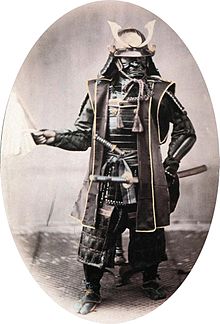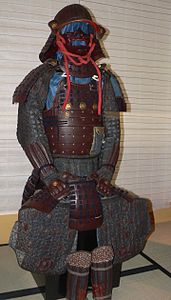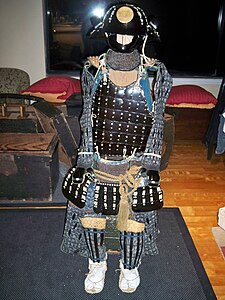Japanese armor


- Breastplate - dō / hotokedō ( 胴 (仏 胴) )
- Apron links - kusazuri ( 草 摺 )
- Thigh protection - haidate ( 佩 楯 )
- tateage ( 立 挙 )
- Legguards - (shino-) suneate ( 臑 当 (篠 臑 当) )
- Back of the foot protection - kōgake ( 甲 懸 )
- Shoulder plates - (tōsei-) sode ( 袖 (当 世 袖) )
- Combat glove - kote (shino-gote) ( 籠 手 (篠 籠 手) )
- Back of the hand protection - tekkō / tekō (tsumi-tekkō) ( 手 甲 (摘 手 甲) )
- Helmet - kabuto (hinenonari-Zunari-kabuto) ( 兜 (日 根 野 形 頭 形 兜) )
- Neck wrap - koshimaki ( 腰 巻 )
- Glare protection - mabisashi ( 眉 庇 )
- Temple plate - fukikaeshi ( 吹 返 )
- Neck protection - (hineno-) shikoro ( し こ ろ (日 根 野 し こ ろ) )
- Helmet decoration (here: water buffalo horns ) - tatemono (suigyū no wakidate) ( 立 物 (水牛 の 脇 立) )
- Helmet jewelry (here: sun disk) - tatemono (nichirin no maedate) ( 立 物 (日 輪 の 前 立) )
- Face mask - mempō ( 面 頬 (目 の 下 頬) )
- Coat of arms - shide ( 垂 )
- Joint from the collar - erimawashi ( 襟 廻 )
Yoroi [ joɺoi ] ( Japanese 鎧 or seldom 甲 ) is the Japanese generic term for armor of all kinds. The Japanese term also includes armor of the western type, but is only used in European texts for Japanese armor .
In detail these are:
- Tankō ( 短 甲 ) ( Kofun period )
- Keikō ( 挂甲 ) (Kofun to Nara period )
- Ōyoroi ( 大 鎧 ) ( Heian to Kamakura period )
- Dōmaru ( 胴 丸 ) (middle Heian period )
- Haramaki ( 腹 巻 ) (Kamakura period)
- Tōsei gusoku ( 当 世 具足 ) ( Muromachi period to Azuchi Momoyama period )
- Nanbandō ( 南蛮 胴 ) ( epoch of the Nanban trade ); European armor in Japanese style
General
Under Yoroi refers to a Japanese armor , which is usually of a breastplate, a helmet, arm and leg splints, hand and face protection. These armors are lighter than European variants, but in contrast to the individually used breast armors, they only appear in their entirety. A yoroi was only worn during battle and was rarely used for ceremonial purposes; Palace guards or bodyguards only wore normal clothing. Since the execution of the armor varied depending on the financial means and the combat skills of the soldier, most of the armor was mixed up very colorfully.
purpose
The Japanese armor was primarily used to protect soldiers on the battlefield. Armor had to protect against blows and stabs with a sword, arrows, spear thrusts and blunt injuries, for example from kicks or horse blows.
construction
These details refer largely to the form Tōseigusoku.
A Japanese armor consists of undergarment (usually a kimono or yukata), helmet ( Kabuto ), face mask ( Menpo ) breastplate ( Thu ), hip and thigh protection ( Kusazuri ), bracers ( Kote ), shoulder plates or bars ( Turf ), Pelvic hangers ( Heidate ), thigh and lower leg splints ( Suneate ).
The parts of the armor are laid out in such a way that one can move around in it relatively easily to wield a sword. Nevertheless, the freedom of movement and visibility is severely restricted, which requires the use of swords with long handles, so-called tachis .
The helmet usually has antlers reminiscent of a deer, an ox or the pincers of a beetle. These antlers are made of horn or metal and are more of a hindrance in hand-to-hand combat. A neck protection (Shikoro) made of metal frame or riveted rings is attached to the back of the helmet, which is comparable to the neck protection on today's fire helmets.
The face mask depicts a bellicose grimace, mostly with a glued-on beard and visible teeth. This mask is made of metal and offers protection against cuts to the face, but together with the helmet it severely restricts the field of vision.
Under the helmet, there is a metal ring on the back of many armors, which is suitable for holding a flagpole. Since there were no uniform uniforms and family symbols were difficult to see, almost all soldiers in battles carried their flags with them to indicate their troop membership. Depending on the design and area of application of the armor, the shoulder plates are larger or smaller. In the cavalry, particularly large plates are useful to protect against lances and halberds ( Yari and Naginata ), foot soldiers prefer small plates, often bowl-shaped pieces that offer more freedom of movement and less attack surface for throwing or gripping techniques of the opponent.
The splints on the arms and legs were light but effective against enemy sword blows. However, they also offered the armor's greatest weak point because they could bend or tilt quickly. In addition, certain parts of the arms and legs (such as the calves) were mostly unprotected to ensure freedom of movement.
The hand guards were basically nothing more than leather gloves with wrist and back covers made of metal.
materials
The simplest yorois were made mostly of cotton and leather. Exposed areas were reinforced with bamboo plates. Such armor was cheap and light, its durability was rather mediocre and it offered little protection in battle. Bamboo, which is very light, can be bent into a spherical shape over a flame. In contrast to European scale armor, these plates point upwards and are firmly knotted with cotton thread or wire. This increases its cut resistance. At the same time, the risk of the armor plate simply breaking when hit by a weapon is reduced even further. To protect against moisture, however, it is necessary to coat the platelets with varnish, which only a few soldiers could afford. This armor was used by poor peasants and soldiers, whose only task was to repel the oncoming cavalry with long spears and lances ( yari ). They have practically no protective effect against musket fire.
Wealthier soldiers (usually samurai ) were able to purchase expensive armor with metal armor or even have it made to measure. Luxury versions of the Yoroi also consisted of a lot of cotton and leather, but the breastplate and helmet were made of metal (mostly hardened sheet metal and steel), bracers made of metal wrapped in leather, and less protected areas were at least covered with metal plates, similar to scale armor .
The fight against metal armor and the fight against bamboo-reinforced fabric armor are fundamentally different from each other. While a sword tends to slide off metal armor , the attacker must expect the scabbard edge of his sword to penetrate the bamboo plates and get stuck there with bamboo-reinforced fabric armor . The shape and orientation of the platelets (which point upwards and protrude several centimeters) favors this, as the strongest blows come from above. In this situation the soldier has to rely on the recovery of his weapon or draw a replacement weapon. It should be borne in mind that an army has the majority compared to the samurai. Since this property is an enormous advantage in combat, many metal armor was also provided with larger wooden deflectors in the shoulder area, which were knotted and could simply be thrown off if necessary by loosening the lacing. Samurai often fought with their squire, with whom they also lived together and formed a well-coordinated team. The hero depictions in modern films, for example, almost never show these squires, so this fact is little known.
Attention must also be paid to the bullet resistance of both forms of armament. Since the muzzle-loading musket became very popular in the 16th century, the armor had to be used against it. Metal armor was as good as bulletproof over 100 meters in the 17th century. Even with armor, a fast runner manages to overcome this distance before the shooters could reload. In addition, firearms, especially the match rifles that have long been used in Japan, are only suitable for one shot in damp weather (eight months of the year!) And not even this can be considered reliable. Wood-reinforced armor is useless against muskets.
Strengths and weaknesses
Despite the relatively light construction of Japanese armor, it is a highly complex form of protection for the weaponry events of medieval and early modern Japan. Most historical martial and martial arts schools incorporate many techniques for defeating an enemy in armor. Even today, for example, there are many “armor breakers” in Aikido . In the Bujinkan Budo Taijutsu (BBT), too, practically all schools contain techniques that are designed to defeat opponents in armor. Techniques with weapons focus on specific hit areas, such as the calves, buttocks, throat, hands or armpits. All of these points are relatively easy to get to. Unarmed techniques aim to break the “skeleton” of the armor, i.e. to tilt the bracers, to get caught, to play pieces of armor against each other, etc.
This is the actual weak point of the Yoroi, namely the susceptibility to non-circular movements or to catching, tilting and breaking or bending.
Another weak point is - as with all armor - the weight. A soldier who was once on the ground took a relatively long time to get up again. Those seconds could cost him his life, so it made more sense at times to lie down and pretend to be dead and wait until the end of the battle.
It was also easy to get out of whack. A fist hit on the face mask could be fatal if an overly pointed mask pierced the wearer's face; if armor was bent, it was no longer possible to move in it. If parts such as the shoulder plates were bent, they no longer offered any protection.
gallery
- Kofun period armor
- Tōsei gusoku
Okegawa- do gusoku.
Hotoke-dō gusoku
Uchidashi- Yukinoshita-do (or Sendai- do) gusoku.
Nanban- do gusoku.
Karuta tatami-dō gusoku.
Web links
- Japanese armor types and their part names at Usagijuku
- Information about the Yoroi Kumi-Uchi (duel in armor)
- Samurai armor on welt-der-samurai.de, accessed on February 10, 2017.
literature
- Markus Sesko: Katchu - Japanese armor. Lulu Enterprises, 2014, ISBN 978-1-312-67689-3 .
- Anthony J Bryant: Early Samurai AD 200-1500. Osprey, 2014, ISBN 978-1-4728-0038-1 .
- Trevor Absolon: Samurai Armor: The Japanese Cuirass. Volume I, Osprey, 2017, ISBN 978-1-4728-0796-0 .
- Trevor Absolon: Samurai Armor: Helmets, Masks and Other Armor. Volume II, Osprey, 2017, ISBN 978-1-4728-2287-1 .













